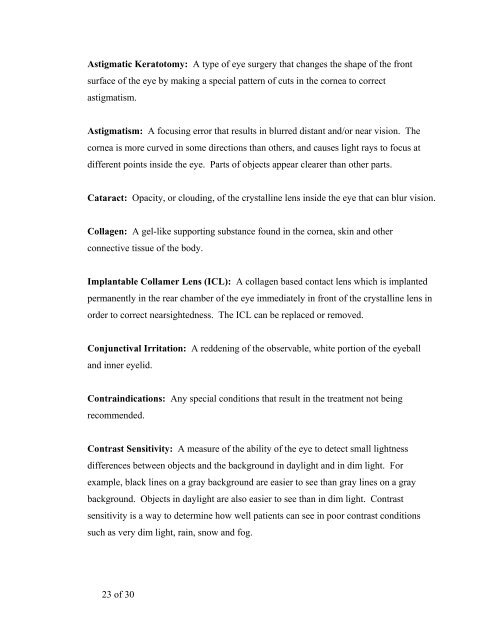ICL Patient Information Booklet
ICL Patient Information Booklet ICL Patient Information Booklet
The ICL is intended to improve your vision However, because you are a nearsighted patient you should consult with your eye doctor on a regular basis (i.e., once a year) to verify the overall health of your eye. Answers to Self-Test Questions: 1. F 6. F 2. F 7. F 3. F 8. F 4. T 9. T 5. T 10. F 14.0 GLOSSARY This section summarizes important terms used in this information booklet or that your eye doctor may discuss with you. Please discuss any related questions with your doctor. Acute Corneal Decompensation: A sudden opacification (clouding) of the usually clear front surface of the eye (cornea). Anterior Capsule: The front surface of the crystalline lens. It is a thin layer of skin totally surrounding the lens much like the skin of a grape. Anterior Chamber: Front chamber of the eye; anterior chamber depth is the thickness of the chamber Antibiotic Medication: A drug used to treat or prevent infection. Your doctor may prescribe this medication after ICL surgery. Anti-inflammatory Medication: A drug that reduces inflammation or the body’s reaction to injury or disease. Any eye surgery can cause inflammation. Your doctor may prescribe the medication after ICL surgery. 22 of 30
Astigmatic Keratotomy: A type of eye surgery that changes the shape of the front surface of the eye by making a special pattern of cuts in the cornea to correct astigmatism. Astigmatism: A focusing error that results in blurred distant and/or near vision. The cornea is more curved in some directions than others, and causes light rays to focus at different points inside the eye. Parts of objects appear clearer than other parts. Cataract: Opacity, or clouding, of the crystalline lens inside the eye that can blur vision. Collagen: A gel-like supporting substance found in the cornea, skin and other connective tissue of the body. Implantable Collamer Lens (ICL): A collagen based contact lens which is implanted permanently in the rear chamber of the eye immediately in front of the crystalline lens in order to correct nearsightedness. The ICL can be replaced or removed. Conjunctival Irritation: A reddening of the observable, white portion of the eyeball and inner eyelid. Contraindications: Any special conditions that result in the treatment not being recommended. Contrast Sensitivity: A measure of the ability of the eye to detect small lightness differences between objects and the background in daylight and in dim light. For example, black lines on a gray background are easier to see than gray lines on a gray background. Objects in daylight are also easier to see than in dim light. Contrast sensitivity is a way to determine how well patients can see in poor contrast conditions such as very dim light, rain, snow and fog. 23 of 30
- Page 1 and 2: 1 of 30 STAAR Surgical Visian ICL
- Page 3 and 4: 3 of 30 TABLE OF CONTENTS 1. Introd
- Page 5 and 6: 1.0 INTRODUC TION The purpose of th
- Page 7 and 8: Wearing glasses and contact lenses
- Page 9 and 10: Description of Study Patient Group:
- Page 11 and 12: 4.0 WHAT ARE THE RISKS OF ICL FOR N
- Page 13 and 14: 6.0 CONTRAIN DICATIONS You should N
- Page 15 and 16: 9.0 ARE YOU A GOOD CANDIDATE FOR IC
- Page 17 and 18: After the iridotomy procedure, your
- Page 19 and 20: 19 of 30 eyeglasses increase over t
- Page 21: ICL surgery does not eliminate the
- Page 25 and 26: Excimer Laser: A type of laser used
- Page 27 and 28: Nearsightedness: A focusing error t
- Page 29 and 30: YAG Laser: (Yttrium Aluminum Garnet
Astigmatic Keratotomy: A type of eye surgery that changes the shape of the front<br />
surface of the eye by making a special pattern of cuts in the cornea to correct<br />
astigmatism.<br />
Astigmatism: A focusing error that results in blurred distant and/or near vision. The<br />
cornea is more curved in some directions than others, and causes light rays to focus at<br />
different points inside the eye. Parts of objects appear clearer than other parts.<br />
Cataract: Opacity, or clouding, of the crystalline lens inside the eye that can blur vision.<br />
Collagen: A gel-like supporting substance found in the cornea, skin and other<br />
connective tissue of the body.<br />
Implantable Collamer Lens (<strong>ICL</strong>): A collagen based contact lens which is implanted<br />
permanently in the rear chamber of the eye immediately in front of the crystalline lens in<br />
order to correct nearsightedness. The <strong>ICL</strong> can be replaced or removed.<br />
Conjunctival Irritation: A reddening of the observable, white portion of the eyeball<br />
and inner eyelid.<br />
Contraindications: Any special conditions that result in the treatment not being<br />
recommended.<br />
Contrast Sensitivity: A measure of the ability of the eye to detect small lightness<br />
differences between objects and the background in daylight and in dim light. For<br />
example, black lines on a gray background are easier to see than gray lines on a gray<br />
background. Objects in daylight are also easier to see than in dim light. Contrast<br />
sensitivity is a way to determine how well patients can see in poor contrast conditions<br />
such as very dim light, rain, snow and fog.<br />
23 of 30



